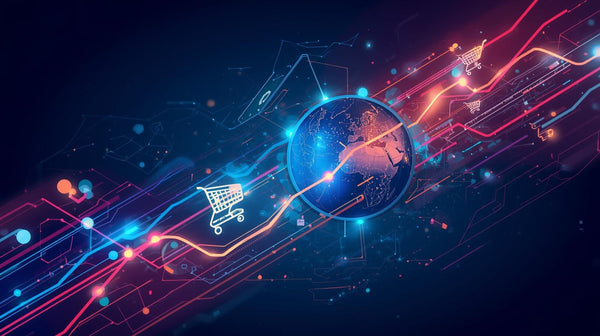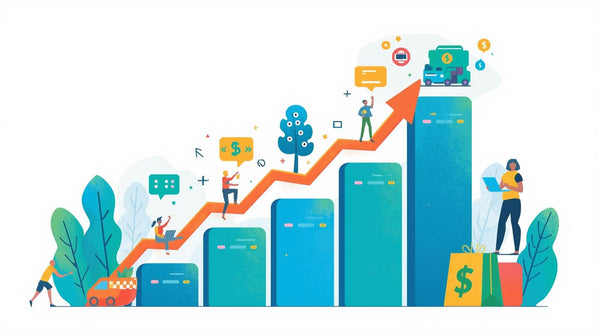The world of commerce is on the brink of a transformative evolution, driven by the relentless advancement of technology. E-commerce, which has already revolutionized the way we buy and sell, is poised to undergo an even more profound metamorphosis. As we look ahead, we see a future teeming with possibilities—where innovations, trends, and disruptions will mold the landscape of commerce into something unimaginably different from what we know today.
1. Hyper-Personalization: Crafting Individualized Shopping Experiences
The future of e-commerce will be synonymous with hyper-personalization. Advanced data analytics and artificial intelligence will enable businesses to create tailor-made shopping experiences for each consumer. From personalized product recommendations to dynamic pricing based on individual preferences and purchase history, hyper-personalization will be the cornerstone of customer engagement.
2. Augmented Reality (AR) and Virtual Reality (VR): Redefining Shopping Interaction
Augmented Reality and Virtual Reality will eliminate the disconnect between online and in-store shopping. Consumers will be able to virtually try on clothing, visualize furniture in their homes, and experience products in a fully immersive way. This technological leap will not only boost consumer confidence but also transform the way brands showcase their offerings.
3. Voice Commerce: Conversational Transactions Take Center Stage
Voice assistants will become integral to our shopping routines. Voice commerce will enable consumers to effortlessly purchase products by simply speaking aloud. Brands will need to optimize for voice search and invest in voice-enabled shopping experiences to cater to this burgeoning trend.
4. Mobile Commerce Evolution: A Mobile-First World
Mobile devices will continue to dominate e-commerce, emphasizing the importance of mobile-first strategies. Brands that prioritize mobile responsiveness, fast loading times, and intuitive user interfaces will thrive in this environment, as consumers increasingly turn to their smartphones for shopping.
5. Sustainability and Ethical Commerce: Ethical Shopping Takes the Spotlight
Conscious consumerism will drive the demand for sustainable and ethically sourced products. Brands that demonstrate transparency in their supply chains, environmentally friendly practices, and ethical sourcing will attract a growing cohort of conscious shoppers.
6. Cryptocurrencies and Blockchain: Revolutionizing Payments and Security
Cryptocurrencies will expand beyond investment vehicles to become accepted methods of payment. Blockchain technology will enhance transaction security, prevent fraud, and streamline supply chain management, offering transparency and traceability that consumers crave.
7. Social Commerce: Shopping Meets Social Media
Social media platforms will morph into shopping hubs, offering seamless purchase experiences. Brands will leverage social commerce to showcase products within users' feeds and drive direct purchases through platforms like Instagram and Facebook.
8. AI-Powered Customer Service: Chatbots Redefine Support
Artificial intelligence-driven chatbots will provide instant customer support, answering queries, and offering real-time assistance. AI will also power predictive analytics, helping businesses anticipate consumer behavior and tailor their strategies accordingly.
9. Drone and Autonomous Delivery: Transforming Last-Mile Logistics
Delivery will evolve with the use of drones and autonomous vehicles, revolutionizing last-mile logistics. This shift will expedite deliveries, reduce costs, and offer customers faster and more efficient shipping options.
10. Globalization and Cross-Border E-Commerce: Expanding Horizons
Improved logistics and technology will enable businesses to effortlessly tap into international markets. Cross-border e-commerce will become the norm, necessitating support for multi-currency transactions, localized content, and efficient international shipping.
11. Subscription Models: Convenience Meets Customer Loyalty
Subscription-based models will surge, offering consumers convenience and brands recurring revenue streams. From streaming services to curated product boxes, subscriptions will foster customer loyalty and drive predictable sales.
12. Influencer Commerce: Bridging Trust and Purchase Intent
Influencer marketing will evolve into influencer commerce, where influencers directly sell products to their followers. This approach will bridge the gap between authentic endorsements and immediate purchasing decisions.
13. Robotics and Automation: Streamlining Warehousing and Fulfillment
Warehousing and fulfillment will undergo automation, with robots handling tasks such as picking, packing, and shipping. This transformation will streamline operations, reduce errors, and expedite order processing.
14. Data Privacy and Security: Preserving Consumer Trust
As e-commerce thrives, data privacy and security will take center stage. Businesses must adopt robust cybersecurity measures to safeguard customer data and maintain their trust.
15. Enhanced Payment Methods: Seamless Checkout Experiences
Payment methods will evolve to offer frictionless and secure checkout experiences. Biometric authentication, mobile wallets, and one-click payments will become commonplace, reducing cart abandonment rates.
16. 3D Printing: Personalized Production and On-Demand Manufacturing
3D printing will enable on-demand manufacturing, allowing businesses to create personalized products swiftly. This technology will revolutionize the production process, offering greater flexibility and reducing waste.
17. Quantum Computing: Revolutionizing Data Analysis
Quantum computing's immense processing power will revolutionize data analysis and enable businesses to extract insights from vast datasets in real-time. This capability will refine customer targeting, marketing strategies, and supply chain optimization.
18. Digital Identity Verification: Streamlining User Authentication
Digital identity verification will simplify user authentication processes, enhancing security and reducing friction during online transactions. This technology will accelerate account creation, logins, and payment verifications.
19. Chat Commerce: Conversational Selling
Conversational commerce will extend beyond customer support, enabling consumers to make purchases directly through chat applications. Brands will leverage chatbots for personalized recommendations and easy purchasing.
20. Data-Driven Predictive Analytics: Anticipating Trends
Predictive analytics will become more sophisticated, empowering businesses to anticipate consumer trends and demands. Data-driven insights will guide inventory management, marketing campaigns, and product launches.
21. Green Packaging and Sustainable Shipping: Eco-Friendly Logistics
Sustainability will extend to packaging and shipping, with businesses adopting eco-friendly materials and efficient shipping practices. Green packaging will resonate with environmentally conscious consumers.
22. Enhanced Customer Engagement: Immersive Experiences
E-commerce will prioritize customer engagement through immersive experiences, interactive content, and gamification. This approach will foster brand loyalty and extend time spent on websites.
23. Emotional Intelligence in AI: Understanding Consumer Sentiments
AI will evolve to understand and respond to consumer emotions, enhancing personalized interactions. Emotional intelligence will enable AI to cater to consumer sentiments and offer empathetic support.
24. Quantum Encryption: Unbreakable Security
Quantum encryption will offer unparalleled security for online transactions. This technology will prevent data breaches and secure sensitive information, assuring consumers of their privacy.
25. Edge Computing: Faster Processing and Reduced Latency
Edge computing will expedite data processing and reduce latency for real-time interactions. E-commerce platforms will offer smoother shopping experiences and rapid responses to user actions.
26. Virtual Try-On: Testing Products Digitally
Virtual try-on experiences will extend beyond fashion to various product categories. Customers will be able to digitally test products before making purchase decisions, enhancing consumer confidence.
27. Neuro-Marketing: Tapping into Brain Signals
Neuro-marketing will leverage brain-computer interfaces to understand consumer preferences and reactions. This technology will enable businesses to tailor marketing efforts with unprecedented accuracy.
28. E-Commerce Marketplaces: Expanding Platforms
E-commerce marketplaces will continue to grow, offering a one-stop shop for consumers. Brands will diversify their sales channels by participating in multiple marketplaces to reach a broader audience.
29. Social Responsibility Integration: Aligning with Causes
Brands will integrate social responsibility and philanthropy into their business models. Consumers will gravitate toward businesses that align with their values and contribute to social causes.
30. Biometric Shopping: Secure and Convenient Transactions
Biometric authentication will become central to secure shopping experiences. Fingerprints, facial recognition, and even iris scans will facilitate secure payments and account access.
Conclusion
As we peer into the future of e-commerce, we witness a tapestry of innovation, convenience, and engagement. Hyper-personalization, AR/VR experiences, sustainability, blockchain, and many other trends will shape a landscape where shopping transcends its current limitations. The evolution of e-commerce will not only transform businesses but also redefine how consumers perceive, interact with, and experience commerce. Embracing these trends and technologies is essential for businesses seeking to thrive in this dynamic and ever-evolving realm of commerce.





0 comments